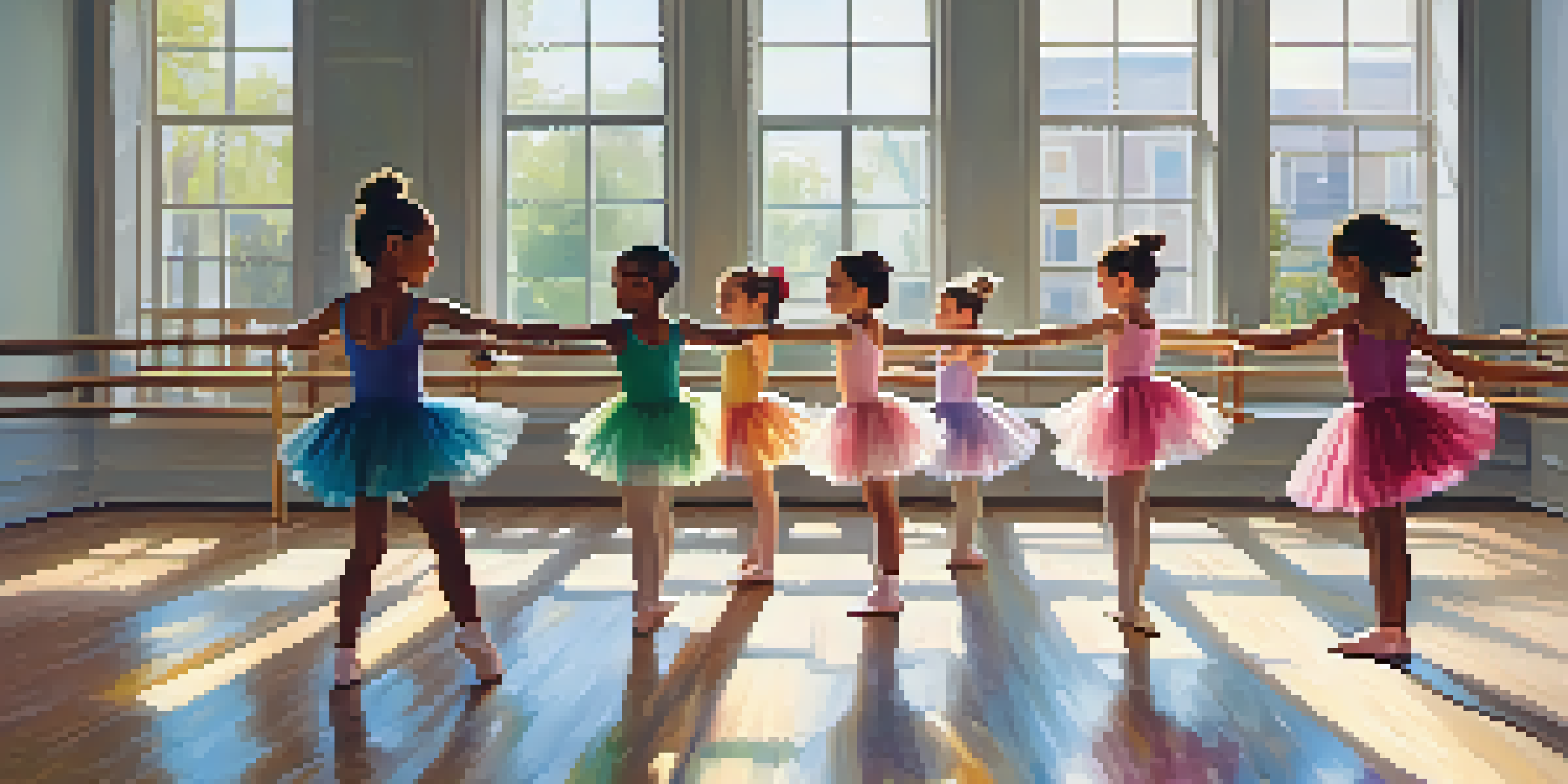The Psychological Benefits of Dance in Child Development

Dance as a Tool for Emotional Expression in Kids
Dance is a powerful outlet for children to express their emotions. Through movement, they can convey feelings that might be hard to articulate in words. Whether it’s joy, sadness, or excitement, dance allows kids to explore and understand their emotional landscape.
Dance is the hidden language of the soul.
For example, a child who feels overwhelmed by anxiety may find solace in rhythmic movements, channeling their nervous energy into dance. This process not only helps them release pent-up feelings but also teaches them how to cope with their emotions in a healthy way. Over time, this can build their emotional resilience.
Moreover, dance fosters a sense of individuality, encouraging children to celebrate their unique emotional experiences. By allowing them to express themselves creatively, dance becomes a safe space where they can explore their feelings without judgment.
Boosting Self-Esteem Through Dance Participation
Engagement in dance can significantly boost a child's self-esteem. When children learn new dance moves or perform in front of others, they experience a sense of accomplishment. This feeling of achievement can be incredibly empowering, especially for those who may struggle in traditional academic settings.

For instance, a shy child who successfully completes a dance routine can feel a surge of confidence. Each small victory in mastering a step or performing in front of an audience builds their self-worth. As they continue to dance, they learn to appreciate their abilities and develop a more positive self-image.
Dance as Emotional Expression
Dance allows children to express and understand their emotions through movement, fostering emotional resilience.
Additionally, being part of a dance group fosters camaraderie and support among peers. This sense of belonging can further enhance their confidence, as they realize that they are valued members of a team, contributing to a shared goal.
Enhancing Social Skills Through Dance Interaction
Dance is inherently social, making it a fantastic way for children to develop their social skills. Whether in a group class or during a performance, children learn to interact with peers, share space, and collaborate on routines. These experiences teach them essential social cues and foster teamwork.
Dance is the joy of movement and the heart of life.
Consider a dance class where children must work together to create a group performance. In this setting, they learn to communicate effectively, negotiate roles, and provide constructive feedback. These interactions are vital for building friendships and understanding social dynamics.
Moreover, dance can help children navigate social situations that might feel intimidating. By practicing social engagement in a fun and supportive environment, they become more comfortable interacting with others, both on and off the dance floor.
Improving Cognitive Function Through Dance Learning
Engaging in dance has been shown to improve cognitive function in children. Learning choreography and remembering steps require concentration and memory, skills that are transferable to academic settings. Dance encourages kids to think critically and solve problems creatively as they interpret music and movement.
For example, a child learning a complex routine must pay attention to the timing, rhythm, and spatial awareness. This cognitive engagement sharpens their focus and enhances their ability to process information. Over time, kids who dance may find that their attention span in school improves as well.
Building Self-Esteem Through Dance
Participation in dance boosts children's self-esteem by providing a sense of accomplishment and belonging.
Additionally, dance often incorporates elements of math and spatial awareness, such as counting beats or understanding patterns. This integration of physical movement with cognitive tasks makes learning more dynamic and enjoyable for children.
Cultivating Discipline and Commitment Through Dance Practice
Dance requires practice and dedication, teaching children the importance of discipline. Regularly attending classes and rehearsing routines instills a sense of responsibility and commitment in young dancers. These qualities are essential not only in dance but also in various aspects of life.
For instance, a child who commits to learning a dance piece learns to manage their time effectively, balancing practice with other responsibilities. This practice of setting goals and working toward them translates into better habits in schoolwork and personal life.
Moreover, through the ups and downs of mastering a dance routine, children learn resilience. They realize that setbacks are part of the learning process, which helps them develop a growth mindset, encouraging perseverance in the face of challenges.
Fostering Creativity and Imagination Through Dance
Dance is a form of creative expression that allows children to tap into their imagination. When children dance, they can experiment with movement, explore different styles, and even create their own routines. This freedom fosters creativity, which is essential for problem-solving and innovative thinking.
For example, a child might be inspired by a story or a piece of music and translate those feelings into movement. This imaginative process not only enhances their artistic abilities but also encourages them to think outside the box in everyday situations.
Enhancing Social Skills via Dance
Dance promotes social interaction, enabling children to develop essential communication and teamwork skills.
Furthermore, creativity nurtured through dance can have a ripple effect in other areas of life. Children who feel free to express themselves in dance are often more willing to explore their creativity in art, writing, or other pursuits, leading to a well-rounded development.
Promoting Mental Health and Well-Being Through Dance
Incorporating dance into a child's routine can significantly enhance their mental health. Physical activity releases endorphins, which are known as 'feel-good' hormones, helping to combat feelings of anxiety and depression. For children, dance can be a joyful way to connect with their bodies and boost their mood.
For instance, a child who feels stressed from school might find relief through a lively dance session, where they can shake off their worries and reconnect with themselves. This physical release can be a powerful tool for managing emotions and fostering a positive mindset.

Moreover, dance often involves music, which has its own therapeutic benefits. The combination of movement and music can create a holistic experience that promotes relaxation, mindfulness, and emotional balance, contributing to overall mental well-being.